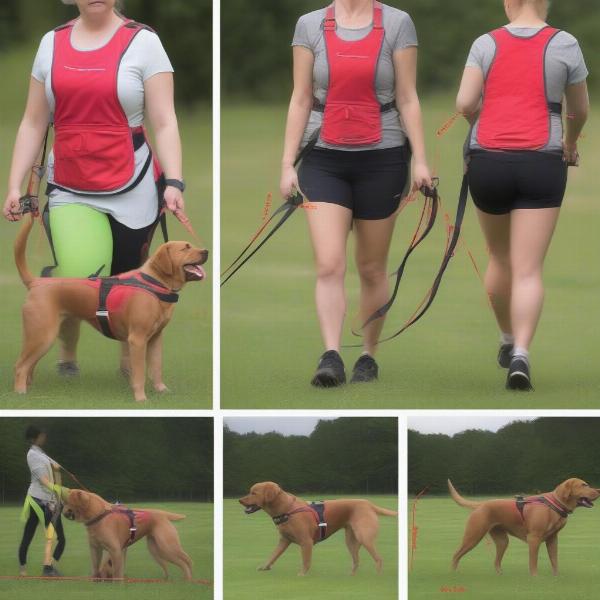A dog running harness is an essential piece of equipment for any active dog owner. Whether you enjoy a leisurely jog around the park or are a serious canicross enthusiast, the right harness can make all the difference to both your comfort and your dog’s. This article will guide you through everything you need to know about choosing the perfect dog running harness, from understanding the different types available to ensuring a proper fit.
Choosing the right dog running harness can significantly impact your dog’s comfort and safety during runs. There are several factors to consider, including the type of activity, your dog’s breed and size, and the harness’s features. A well-fitting harness distributes pressure evenly, preventing choking and allowing your dog to move freely. It also offers better control than a collar, reducing the risk of pulling and strain on your dog’s neck.
Types of Dog Running Harnesses
There are three primary types of dog running harnesses, each designed with specific functionalities in mind:
Back-Clip Harnesses
These are the most common type, featuring a leash attachment point on the dog’s back. They’re suitable for casual walks and runs with dogs who don’t pull excessively. Back-clip harnesses are generally easy to put on and take off and offer good freedom of movement.
Front-Clip Harnesses
These harnesses have the leash attachment point on the dog’s chest. This design helps discourage pulling by gently redirecting the dog’s forward motion when they strain on the leash. Front-clip harnesses are a good choice for dogs who tend to pull or lunge.
Dual-Clip Harnesses
These versatile harnesses offer both front and back leash attachment points, giving you the flexibility to switch between the two depending on the situation. Dual-clip harnesses provide maximum control and are suitable for a variety of activities.
Finding the Perfect Fit
A properly fitted harness is crucial for your dog’s comfort and safety. Too tight, and it can restrict movement and cause chafing. Too loose, and your dog might slip out.
-
Measure your dog: Use a flexible measuring tape to measure around your dog’s chest, just behind the front legs. Refer to the harness manufacturer’s size chart to determine the correct size.
-
Adjustability: Look for harnesses with multiple adjustment points. This allows you to customize the fit for your dog’s specific body shape.
-
Padding and Material: Choose a harness made from breathable, durable materials with adequate padding in areas that rub against your dog’s skin.
-
Try it on: Ensure the harness fits snugly but not too tightly. You should be able to fit two fingers between the harness and your dog’s body.
 Fitting a Dog Running Harness
Fitting a Dog Running Harness
Key Features to Consider
-
Reflective elements: For enhanced visibility during early morning or evening runs.
-
Handle: A sturdy handle on the back of the harness can be useful for lifting your dog over obstacles or for extra control in challenging situations.
-
ID tag attachment: Look for a harness with a dedicated spot to attach your dog’s identification tag.
Choosing a Harness for Specific Activities
-
Canicross: For canicross, a specialized canicross dog harness is recommended. These harnesses are designed to distribute the pulling force evenly across the dog’s body, minimizing strain.
-
General running: A running dog harness with a back or dual-clip design is suitable for general running activities.
“A well-fitting harness is essential for both the dog’s comfort and the handler’s control,” says Dr. Emily Carter, DVM, a certified canine rehabilitation therapist. “It allows the dog to move freely and naturally while preventing injuries and ensuring a pleasant running experience.”
Conclusion
Investing in a quality dog running harness is a wise decision for any active dog owner. By carefully considering the different types of harnesses, ensuring a proper fit, and looking for key features, you can find the perfect harness to make your runs together safe, comfortable, and enjoyable. Remember, a suitable harness can prevent injuries and improve your bond with your furry running companion. Choosing the right dog running harness is crucial for both your dog’s well-being and your enjoyment of running together.
how to tell if your dog broke his leg
FAQ
- How do I know if my dog’s harness is the right fit? You should be able to fit two fingers between the harness and your dog’s body.
- What type of harness is best for a dog that pulls? A front-clip or dual-clip harness can help discourage pulling.
- Is a running harness necessary for all dogs? While not strictly necessary for all dogs, a harness is generally recommended for running, especially for longer distances or more strenuous activities.
- Can I use a regular walking harness for running? Some walking harnesses can be used for running, but dedicated running harnesses often provide better support and distribution of pulling force.
- How do I clean my dog’s running harness? Most harnesses can be hand-washed or machine-washed on a gentle cycle.
- What material is best for a running harness? Breathable, durable materials like nylon or mesh are good choices.
- Can puppies wear running harnesses? Yes, but make sure to choose a puppy-sized harness that fits properly and allows for growth.
ILM Dog is your trusted global resource for all things canine. From breed selection to health and wellness, training, nutrition, grooming, exercise, and even travel tips, we provide practical, evidence-based information for dog owners of all experience levels. We also offer expert advice on products and accessories, helping you make informed decisions for your furry friend. For personalized guidance or to learn more about our services, contact us at [email protected] or call +44 20-3965-8624. Visit ILM Dog for a wealth of reliable information to help you navigate the exciting world of dog ownership.